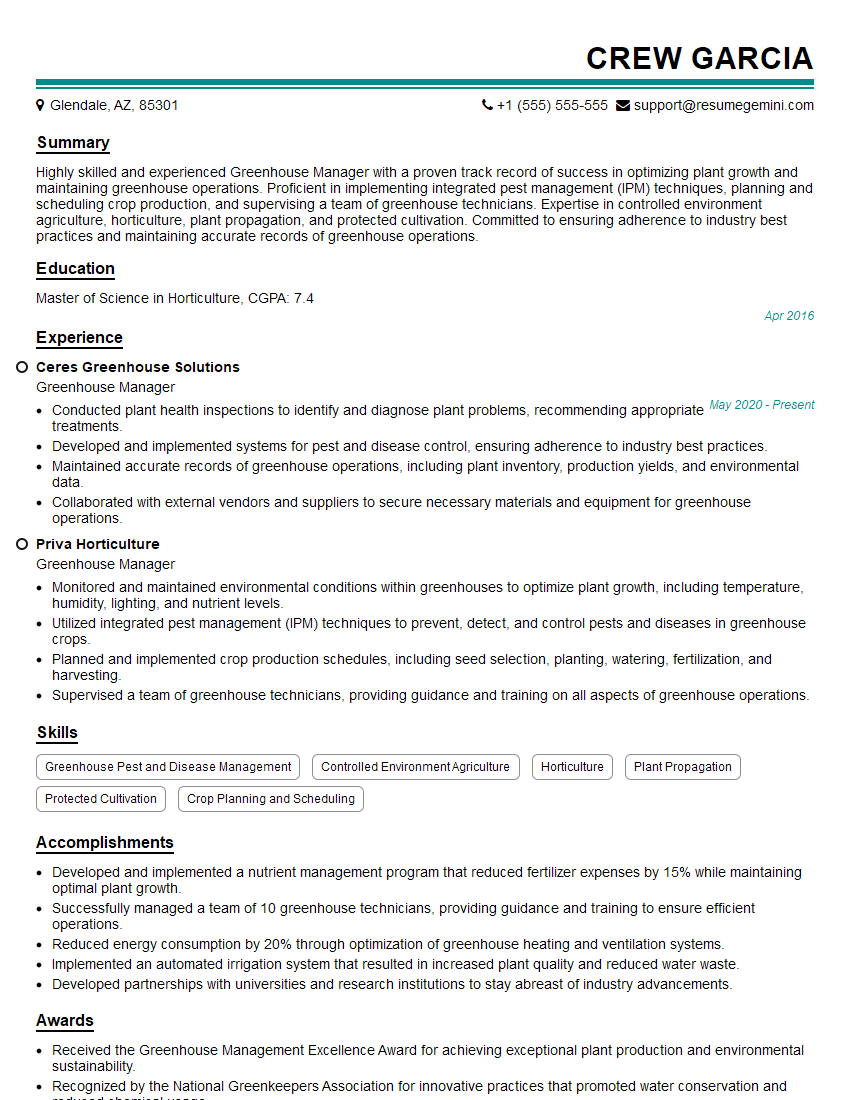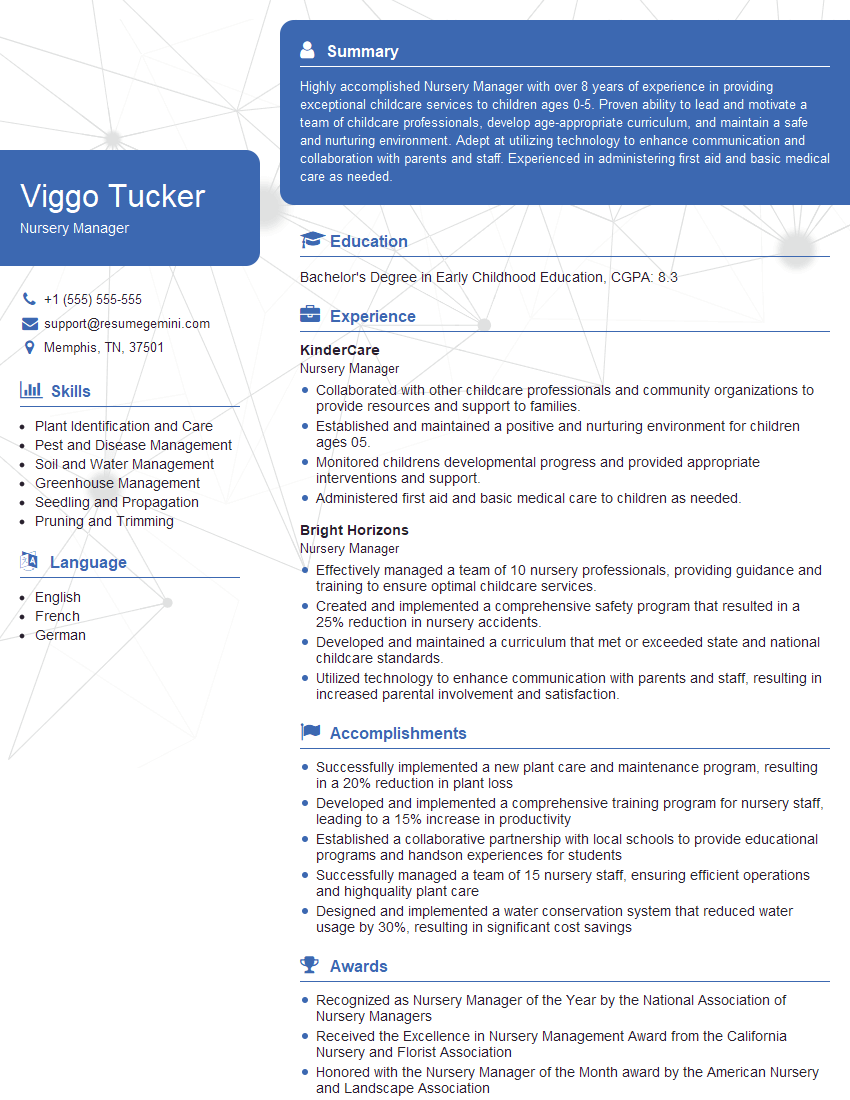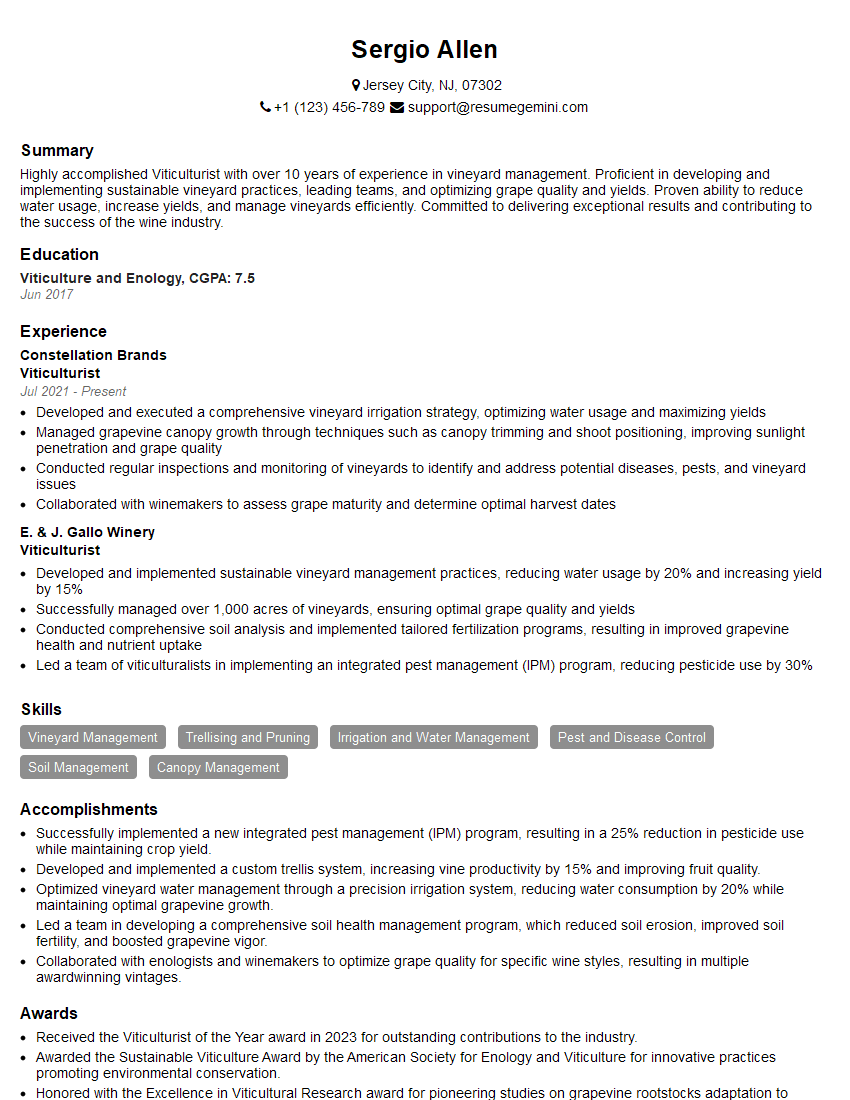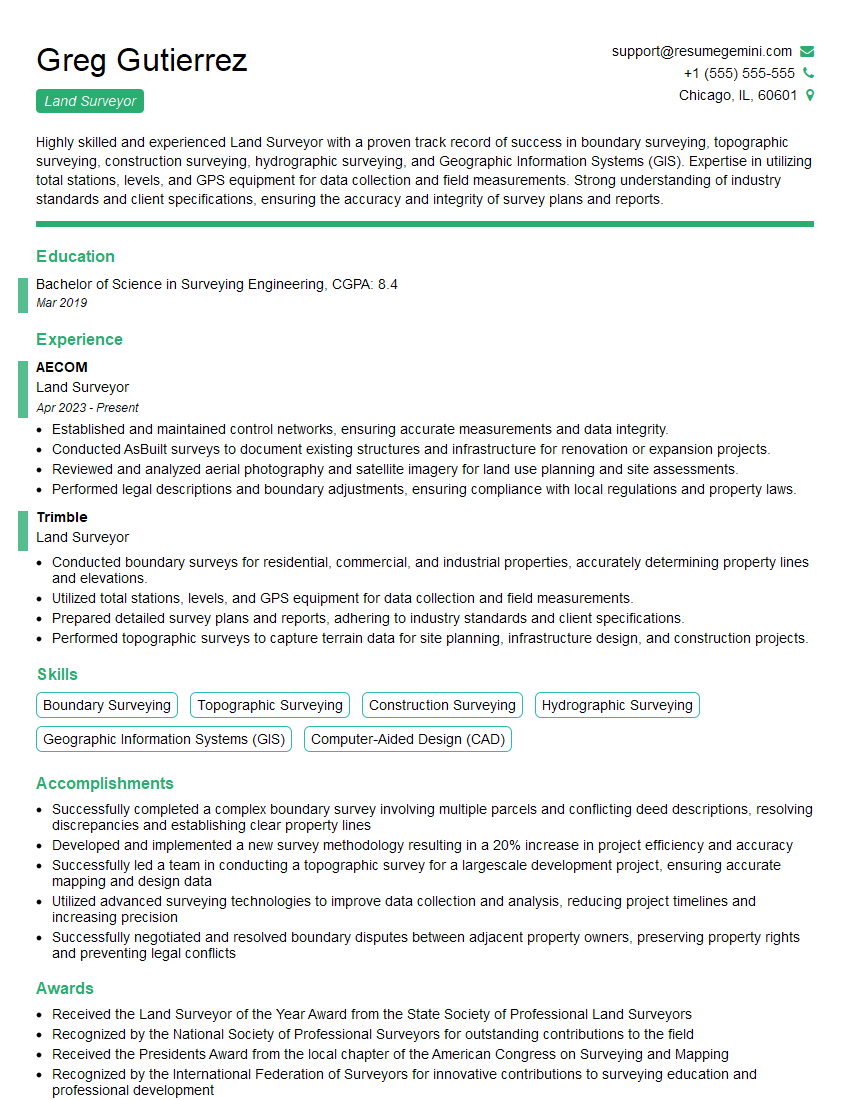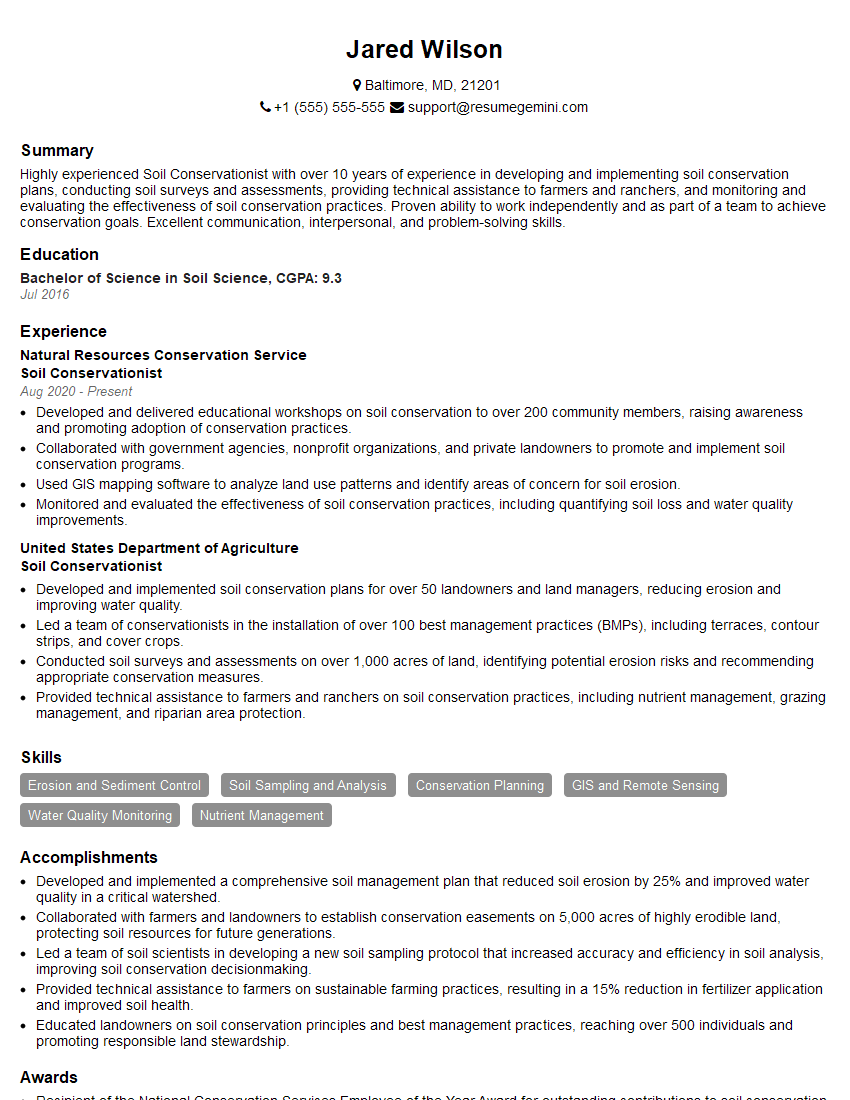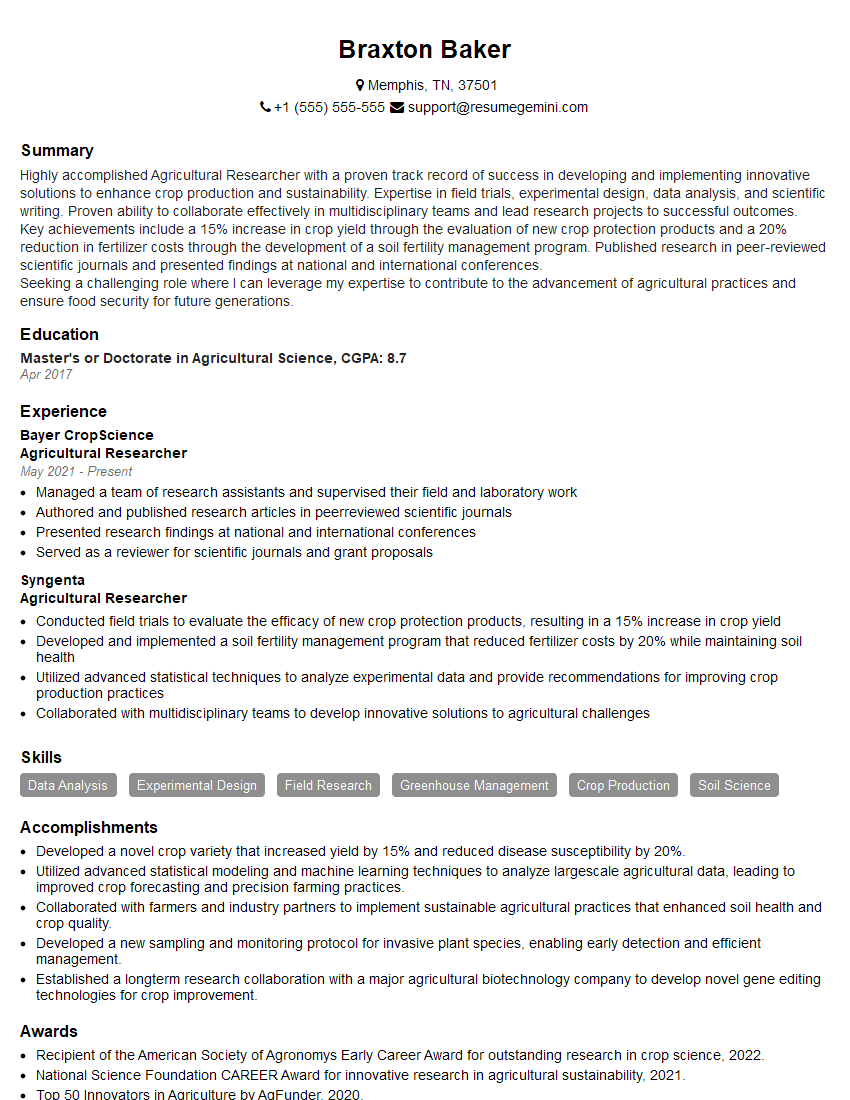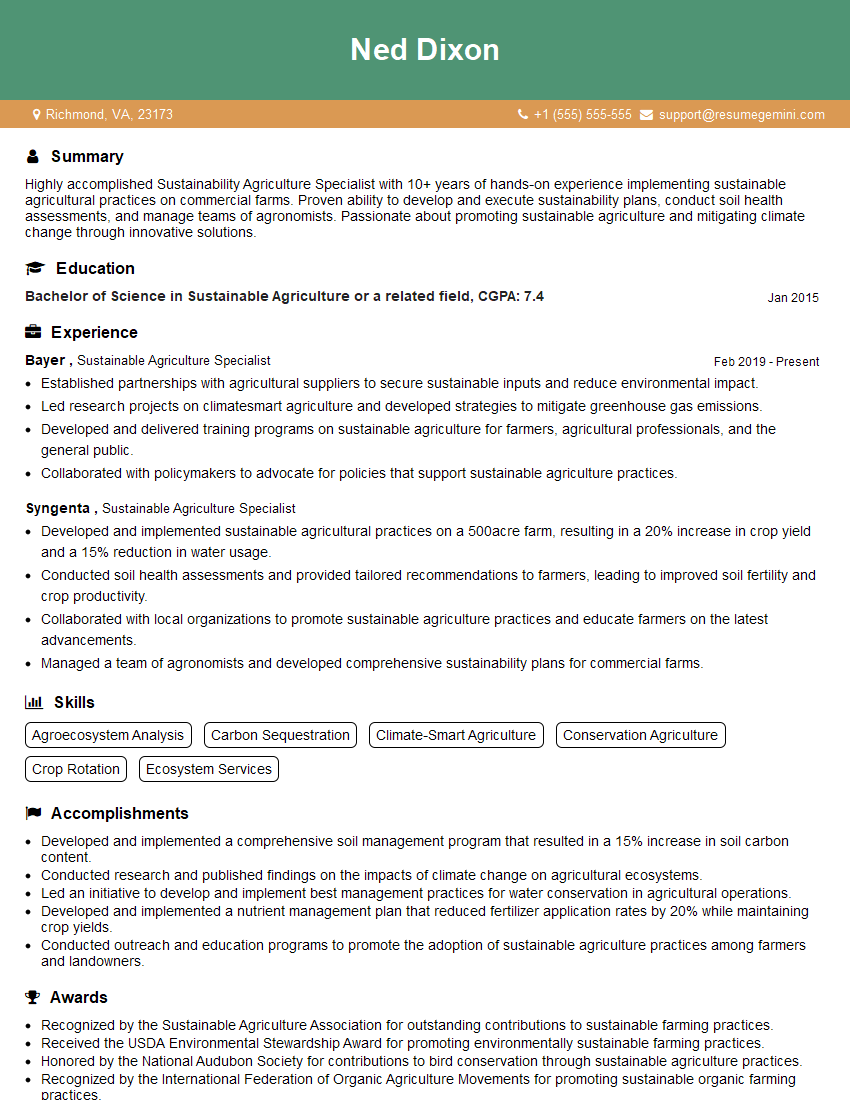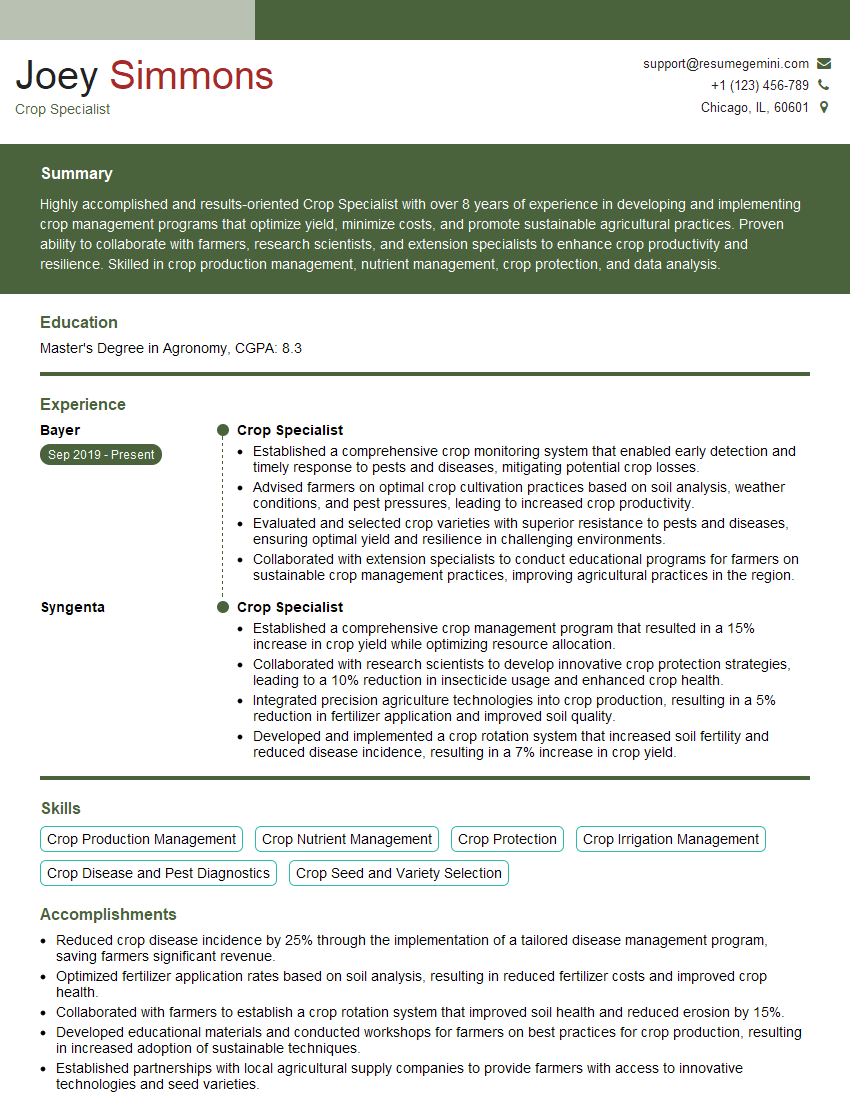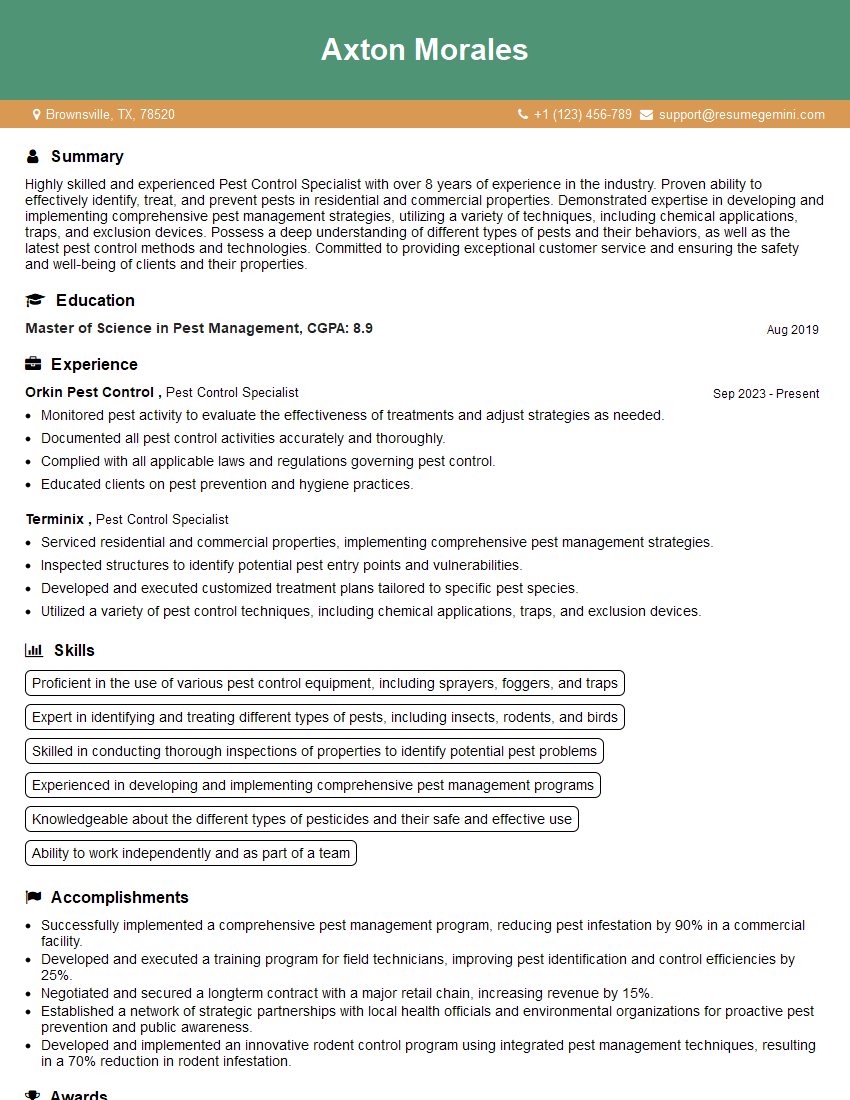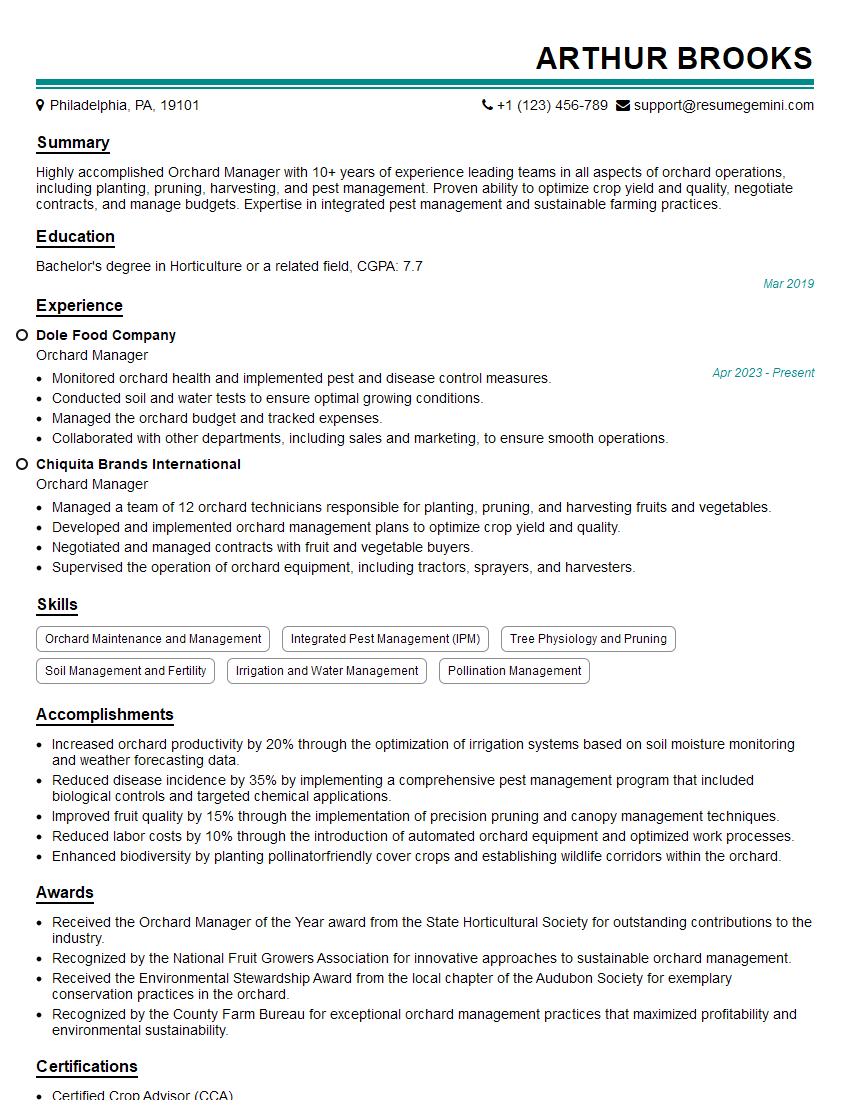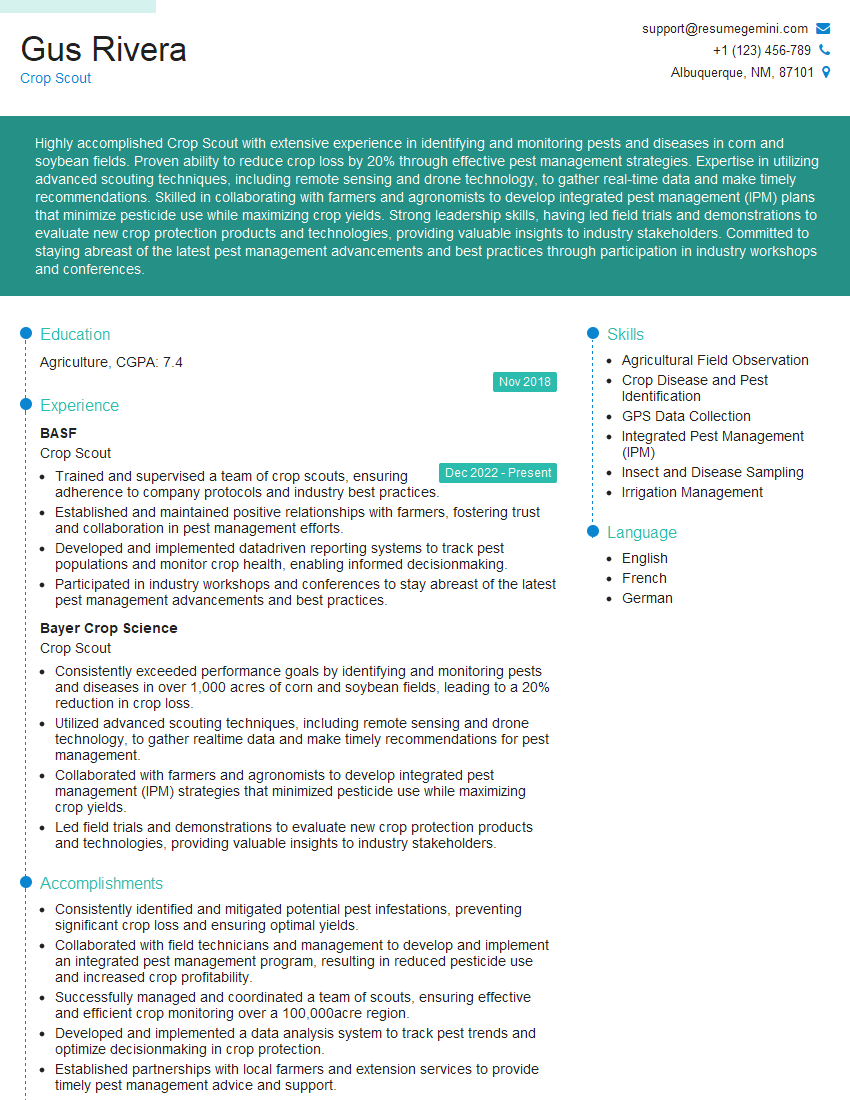Cracking a skill-specific interview, like one for Cultivating Land, requires understanding the nuances of the role. In this blog, we present the questions you’re most likely to encounter, along with insights into how to answer them effectively. Let’s ensure you’re ready to make a strong impression.
Questions Asked in Cultivating Land Interview
Q 1. Describe your experience with different soil types and their suitability for various crops.
Understanding soil types is fundamental to successful cultivation. Different soils vary dramatically in their texture, structure, drainage, and nutrient content, directly impacting crop suitability. For example, sandy soils, while well-draining, are prone to nutrient leaching and water scarcity, making them better suited for drought-tolerant crops like certain varieties of beans or sunflowers. Conversely, clay soils, which retain water well, can become waterlogged, hindering root development and favoring crops like rice that thrive in water-saturated conditions. Loam soils, a mixture of sand, silt, and clay, generally offer the best balance of properties, supporting a wider range of crops.
- Sandy Soils: Excellent drainage, but poor water and nutrient retention. Suitable for crops with low water requirements.
- Clay Soils: High water retention, but poor drainage and aeration. Suitable for crops tolerant of waterlogged conditions.
- Silty Soils: Good water retention and drainage. Generally suitable for a wide variety of crops.
- Loam Soils: A balanced mix, offering good drainage, water retention, and aeration. Ideal for most crops.
My experience spans working with diverse soil types across various regions. I’ve learned to adapt cultivation practices based on the specific soil characteristics of each field, conducting soil tests regularly to monitor nutrient levels and pH, and implementing tailored strategies for fertilization and irrigation accordingly. I’ve successfully grown a wide range of crops by understanding and matching the needs of each crop to the strengths of the available soil.
Q 2. Explain your understanding of crop rotation and its benefits.
Crop rotation is a crucial agricultural practice that involves systematically changing the type of crop grown in a particular field from one season or year to the next. Think of it like giving your land a ‘nutritional break’. It’s not just about diversifying your harvest; it’s about improving soil health and reducing the impact of pests and diseases.
- Improved Soil Health: Different crops have different nutrient requirements. Rotating crops helps prevent depletion of specific nutrients in the soil. For instance, legumes (like beans and peas) fix nitrogen in the soil, benefiting subsequent crops.
- Pest and Disease Management: Rotating crops disrupts the life cycle of many pests and diseases that may build up when the same crop is grown repeatedly in the same location. This reduces the need for chemical interventions.
- Weed Control: Certain cropping sequences can naturally suppress weed growth. For example, cover crops can compete with weeds, reducing their establishment and growth.
- Increased Yield: By improving soil health and reducing pest pressure, crop rotation can contribute to higher yields over the long term.
For example, a common rotation might involve planting a legume in one year (to fix nitrogen), followed by a cereal crop (like wheat or corn) in the next, then a root crop (like potatoes or carrots) in the third year. Each crop’s unique characteristics contribute to the overall health and fertility of the soil. My approach always considers the specific climate, soil type, and pest pressures of the region when designing a crop rotation plan.
Q 3. What are the key indicators of soil health, and how do you assess them?
Soil health is the capacity of soil to function as a vital living ecosystem that sustains plants, animals, and humans. Assessing soil health involves several key indicators:
- Soil Structure: A well-structured soil has good aggregation (clumping of soil particles) creating pores for water and air movement. This can be visually assessed by observing soil texture and tilth, or by measuring soil bulk density.
- Organic Matter Content: High organic matter content improves soil structure, water retention, and nutrient availability. This is typically determined through laboratory analysis.
- Nutrient Levels: Essential nutrients like nitrogen, phosphorus, and potassium are vital for plant growth. Soil tests determine their availability.
- Biological Activity: Healthy soil teems with beneficial microorganisms. Assessing this can involve measuring microbial biomass or the activity of earthworms.
- pH Level: The soil’s pH affects nutrient availability and microbial activity. Soil tests accurately determine the pH.
I assess soil health using a combination of visual observations, simple field tests, and laboratory analyses. Visual observations include assessing soil structure, color, and the presence of earthworms. Field tests can include quick assessments of soil moisture and texture. Laboratory analysis provides precise data on organic matter, nutrient levels, and pH. This multi-faceted approach ensures a comprehensive evaluation of soil health and informs management decisions.
Q 4. How do you manage irrigation efficiently to minimize water waste?
Efficient irrigation is crucial for maximizing crop yields while minimizing water waste. My approach involves several key strategies:
- Drip Irrigation: This delivers water directly to plant roots, minimizing evaporation and runoff. It’s particularly effective in areas with water scarcity.
- Soil Moisture Monitoring: Using soil moisture sensors, I can determine precisely when and how much water the plants need, avoiding overwatering.
- Water Scheduling: Based on weather data, soil moisture levels, and plant water requirements, I create precise irrigation schedules to optimize water use.
- Mulching: Applying mulch helps retain soil moisture by reducing evaporation. This reduces the frequency and amount of irrigation needed.
- Improved Irrigation Infrastructure: Regular maintenance of irrigation systems prevents leaks and ensures efficient water delivery.
For example, in a region with limited water resources, I might implement drip irrigation combined with soil moisture sensors. This allows for precise water application only when and where it’s needed, significantly reducing water waste compared to traditional flood irrigation. Regular monitoring and maintenance of the entire system is key to ensuring long-term efficiency.
Q 5. Describe your experience with pest and disease control in cultivated land.
Pest and disease control is a critical aspect of land cultivation. My approach emphasizes integrated pest management (IPM), a holistic strategy that combines multiple methods to minimize pest and disease impact while reducing reliance on harmful chemicals.
- Crop Rotation: As mentioned earlier, rotating crops disrupts pest and disease cycles, reducing their prevalence.
- Biological Control: Introducing beneficial insects or microorganisms that prey on or compete with pests can effectively control populations naturally.
- Resistant Varieties: Planting crop varieties resistant to common pests and diseases minimizes damage and reduces the need for chemical treatments.
- Monitoring: Regular monitoring of crops for signs of pests and diseases allows for early detection and prompt intervention.
- Targeted Chemical Control: When necessary, using specific, targeted pesticides minimizes environmental impact compared to broad-spectrum chemicals.
For instance, in managing an aphid infestation, I might first introduce ladybugs (a natural aphid predator). If this isn’t sufficient, I might consider a targeted insecticide, only applying it to the affected areas to minimize environmental impact. Regular scouting and monitoring are key to early intervention, preventing widespread infestations. I prioritize minimizing the use of chemicals and selecting the most environmentally sound method possible.
Q 6. What are your strategies for weed management in different cropping systems?
Weed management is essential for maximizing crop yields and maintaining soil health. Strategies vary depending on the cropping system and the specific weeds present.
- Mechanical Control: Techniques like tillage, hoeing, and mowing can effectively control weeds, particularly in smaller areas.
- Cultural Control: Practices like crop rotation, mulching, and cover cropping can suppress weeds naturally. Close planting creates competition that limits weed growth.
- Chemical Control: Herbicides can be used strategically, targeting specific weeds to minimize negative environmental impact. Pre-emergent herbicides prevent weed germination, and post-emergent herbicides target existing weeds.
- Integrated Weed Management (IWM): This holistic approach combines various methods, tailoring the approach to the specific situation.
In a no-till system, I might rely heavily on cover crops and mulching to suppress weeds. In conventional tillage systems, a combination of herbicides and mechanical cultivation might be employed. The key is to adapt the weed management strategy to the specific cropping system and the prevailing weed pressure while prioritizing minimizing environmental risks and promoting soil health.
Q 7. Explain your understanding of fertilization techniques and nutrient management.
Fertilization techniques and nutrient management focus on providing crops with the essential nutrients they need for optimal growth while minimizing environmental impact.
- Soil Testing: Regular soil tests are crucial for determining the existing nutrient levels and pH. This informs fertilizer application rates and types.
- Nutrient Management Plans: These plans outline the types and amounts of fertilizers to be applied based on soil test results, crop requirements, and environmental considerations.
- Organic Fertilizers: These fertilizers, such as compost and manure, improve soil structure and fertility while providing nutrients gradually.
- Inorganic Fertilizers: These fertilizers supply specific nutrients (nitrogen, phosphorus, potassium) in a readily available form. However, overuse can lead to environmental problems.
- Precision Fertilization: Techniques like variable rate fertilization use technology to apply fertilizer at varying rates across a field based on soil nutrient needs, optimizing fertilizer use and reducing waste.
For example, based on a soil test revealing low nitrogen levels, I might incorporate a nitrogen-rich organic fertilizer like compost into the soil prior to planting. Additionally, I may apply a targeted amount of inorganic nitrogen fertilizer at a later stage to meet the specific needs of the crop throughout its growth cycle. My focus is always on balancing the use of organic and inorganic fertilizers to meet the crop’s needs sustainably and protect the environment.
Q 8. How do you monitor crop growth and yield, and what adjustments do you make?
Monitoring crop growth and yield is crucial for optimizing production. It involves a multi-faceted approach combining visual observation with technological tools.
- Visual Inspection: Regularly walking through fields allows for early detection of issues like disease, pest infestations, or nutrient deficiencies. I look for things like leaf color, plant height, and overall vigor. For example, yellowing leaves might indicate a nitrogen deficiency, while stunted growth could signal a problem with water or root development.
- Technological Tools: I utilize tools like remote sensing (drones or satellites) to capture high-resolution imagery which can be analyzed using specialized software to assess crop health across the entire field. This allows for quick identification of areas needing attention. Yield monitors on harvesters provide real-time data during harvest, offering precise yield maps that help to understand variations across the field.
- Data Analysis and Adjustment: The collected data informs decision-making. If a nutrient deficiency is detected in a specific area using remote sensing, I can apply targeted fertilizer application, avoiding unnecessary chemical use and optimizing resource allocation. Similarly, yield maps from harvest help fine-tune planting strategies for the next season.
Adjustments are made based on the data obtained. This might involve altering irrigation schedules, applying pesticides or fertilizers, adjusting planting density in subsequent seasons, or even changing crop varieties based on observed performance.
Q 9. Describe your experience with various tillage methods and their impact on soil health.
Tillage methods significantly impact soil health. My experience encompasses various approaches, each with its own advantages and drawbacks.
- Conventional Tillage: This involves deep plowing to turn over the soil. While it effectively manages weeds and prepares a seedbed, it can lead to soil erosion, compaction, and a loss of soil organic matter. I’ve observed this firsthand on previously conventionally tilled land which suffered from reduced water infiltration and increased runoff.
- Conservation Tillage: This reduces soil disturbance, leaving crop residue on the surface. No-till farming is an extreme example where seeds are directly sown into the previous year’s residue. This preserves soil structure, increases organic matter, enhances water retention, and reduces erosion. However, it necessitates precise weed control methods.
- Reduced Tillage: This falls between conventional and no-till, involving minimal soil disturbance. It balances the benefits of both approaches, offering a practical compromise for many situations. I often use a combination of conservation tillage and precision farming techniques to optimize soil health and yield.
My preference leans towards conservation tillage methods, prioritizing soil health and long-term sustainability. The long-term gains in soil quality outweigh the initial challenges in managing weeds.
Q 10. How do you plan and implement sustainable agricultural practices?
Sustainable agricultural practices are integral to my approach. My planning and implementation focus on several key areas:
- Crop Rotation: Rotating different crops helps to break pest and disease cycles, improve soil fertility, and minimize the need for synthetic fertilizers and pesticides. For example, a rotation of legumes (like beans or clover) can fix nitrogen in the soil, naturally fertilizing subsequent crops.
- Cover Cropping: Planting cover crops during fallow periods helps to prevent erosion, suppress weeds, improve soil structure, and add organic matter. Rye, for instance, is an excellent winter cover crop, protecting the soil from winter erosion.
- Integrated Pest Management (IPM): This approach prioritizes prevention and uses pesticides only as a last resort, focusing on natural methods such as beneficial insects and crop rotation to manage pests. This minimizes the environmental impact of chemical interventions.
- Water Management: Efficient irrigation techniques such as drip irrigation minimize water waste and improve water use efficiency. It also reduces the risk of waterlogging and nutrient leaching.
These practices are not isolated; they work together to build resilience and sustainability in the farming system. My long-term goal is to create a self-sustaining ecosystem where inputs are minimized and outputs are optimized.
Q 11. Explain your understanding of precision agriculture technologies.
Precision agriculture leverages technology to optimize farm management at a highly detailed level. It involves using data to make informed decisions about every aspect of cultivation, from planting to harvest.
- GPS Technology: GPS guidance systems on tractors ensure precise planting and application of inputs, minimizing overlaps and gaps.
- Variable Rate Technology (VRT): VRT allows for the application of inputs like fertilizer and pesticides at varying rates across a field, based on site-specific needs. This optimizes resource use and minimizes environmental impact.
Example: Applying more fertilizer to areas with lower nutrient levels as detected by soil sensors. - Remote Sensing: Drones and satellites provide aerial imagery, allowing for the identification of areas requiring attention, like disease outbreaks or nutrient deficiencies.
- Data Management and Analysis: Sophisticated software collects and analyzes data from various sources, providing insights into crop health, yield, and environmental conditions.
Precision agriculture is a powerful tool that allows for efficiency gains and environmental stewardship by maximizing output while minimizing resource consumption.
Q 12. How do you manage risks associated with weather events and climate change?
Managing risks associated with weather events and climate change requires a proactive and multifaceted approach.
- Diversification: Planting a variety of crops reduces the risk of total crop failure due to a specific weather event. Different crops have different tolerances to drought, frost, or other weather extremes.
- Crop Insurance: Protecting investment through crop insurance is essential to mitigate potential losses from unexpected events.
- Water Management: Investing in efficient irrigation systems and water storage facilities helps manage drought risks.
- Climate-Resilient Varieties: Selecting crop varieties that are better adapted to changing climate conditions, including drought tolerance and heat resistance.
- Weather Forecasting and Monitoring: Closely monitoring weather forecasts and utilizing weather stations provides early warning of impending events, allowing for timely actions like irrigation scheduling or protective measures.
Adapting to climate change is an ongoing process, requiring continuous learning and refinement of strategies.
Q 13. Describe your experience with harvesting and post-harvest handling of crops.
Harvesting and post-harvest handling are critical for preserving crop quality and maximizing economic returns. My experience encompasses various aspects of this process.
- Timing: Harvesting at the optimal maturity stage ensures maximum yield and quality. This involves regular monitoring of crop development and using tools like maturity indices to determine the right time to harvest.
- Equipment: Utilizing appropriate harvesting machinery, properly maintained and calibrated, is essential for efficient and damage-free harvesting. Different crops require different machinery, and proper technique is crucial to minimize losses.
- Post-Harvest Handling: This includes cleaning, drying, storage, and transportation of the harvested crop. Proper storage conditions are vital for preventing spoilage and maintaining quality. For example, proper ventilation is key for grain storage to avoid mold growth. Rapid drying after harvest is vital for many crops to prevent spoilage.
- Quality Control: Regular quality checks throughout the process are essential to ensure the harvested crop meets market standards.
Efficient and careful harvesting and post-harvest handling are essential for maximizing profitability and minimizing losses. This often involves careful attention to detail and adapting procedures to specific crop needs.
Q 14. What are your strategies for minimizing environmental impact of land cultivation?
Minimizing the environmental impact of land cultivation requires a commitment to sustainable practices across all aspects of the operation.
- Reduced Tillage: As mentioned earlier, minimizing soil disturbance reduces erosion and preserves soil health.
- Integrated Pest Management (IPM): Using natural pest control methods reduces reliance on synthetic pesticides, minimizing their negative impacts on beneficial insects and the environment.
- Nutrient Management: Optimizing fertilizer use through soil testing and targeted application reduces nutrient runoff and pollution of water bodies.
- Water Management: Efficient irrigation techniques minimize water waste and reduce the environmental impact of water extraction.
- Cover Cropping: Cover crops improve soil health and reduce erosion, thus minimizing the need for synthetic inputs and reducing environmental impact.
- Renewable Energy: Utilizing renewable energy sources like solar power to reduce reliance on fossil fuels.
Environmental sustainability is not a separate goal but an integral part of my farming philosophy. It’s about building a profitable and environmentally responsible operation for the long term.
Q 15. How do you ensure the safety and welfare of farmworkers?
Farmworker safety is paramount. It’s not just about compliance; it’s about creating a culture of care. My approach is multi-faceted, starting with comprehensive training. This includes safety protocols for machinery operation, chemical handling (with proper PPE training and certification), and hazard recognition (like recognizing signs of heatstroke or identifying potential slips, trips, and falls). We also implement regular safety meetings, providing opportunities for workers to voice concerns and share best practices. Beyond training, I focus on providing adequate and comfortable facilities: clean restrooms, shaded rest areas, and access to fresh drinking water are essential. Finally, I prioritize preventative maintenance on all equipment to minimize the risk of accidents. For example, we perform regular inspections on tractors to ensure brakes and safety features are functioning correctly. A well-maintained work environment leads to fewer accidents and a more productive, engaged workforce.
Career Expert Tips:
- Ace those interviews! Prepare effectively by reviewing the Top 50 Most Common Interview Questions on ResumeGemini.
- Navigate your job search with confidence! Explore a wide range of Career Tips on ResumeGemini. Learn about common challenges and recommendations to overcome them.
- Craft the perfect resume! Master the Art of Resume Writing with ResumeGemini’s guide. Showcase your unique qualifications and achievements effectively.
- Don’t miss out on holiday savings! Build your dream resume with ResumeGemini’s ATS optimized templates.
Q 16. Explain your experience with different types of farm machinery and equipment.
My experience encompasses a wide range of farm machinery, from basic tractors and cultivators to more sophisticated GPS-guided equipment like precision planters and harvesters. I’m proficient in operating and maintaining tractors of various sizes, including those equipped with front-end loaders and implements such as plows, harrows, and tillers. I’m also experienced with self-propelled sprayers, ensuring precise application of fertilizers and pesticides, minimizing environmental impact. I’ve worked extensively with combines for harvesting grain crops and understand the importance of timely maintenance to ensure optimal performance and minimize downtime. Furthermore, I am familiar with post-harvest handling equipment, including grain dryers and storage facilities. My experience also includes the use of smaller equipment such as tillers and weed eaters for precise work in smaller areas.
Q 17. How do you maintain farm records and track productivity?
Maintaining accurate farm records is crucial for profitability and informed decision-making. We utilize a combination of methods. Firstly, we keep detailed field records, noting planting dates, seed varieties, fertilizer and pesticide applications, irrigation schedules, and yields. This information is meticulously logged either in physical notebooks or through dedicated farm management software. Productivity tracking involves monitoring yields per acre, calculating input costs (seeds, fertilizers, labor), and assessing overall profitability for each crop. This data informs future planting decisions, allowing us to optimize resource allocation. For example, we might analyze data to determine which fertilizer type yielded the highest return per acre for a specific crop in a certain field, guiding our choices for the next season. We also track equipment maintenance and repair costs to plan for future expenses. Regular analysis of this data allows us to identify trends, areas for improvement, and potential problems proactively.
Q 18. Describe your experience with livestock management (if applicable).
While my primary expertise is crop cultivation, I have experience managing small livestock operations, specifically poultry. This involved overseeing daily routines including feeding, watering, cleaning, and monitoring the health of the flock. We implemented preventative health measures such as vaccinations and implemented biosecurity protocols to minimize disease risks. We maintained detailed records of feed consumption, egg production, and mortality rates, which were crucial for assessing the efficiency and profitability of the operation. Regular monitoring of animal health and welfare was paramount, allowing us to identify and address any problems quickly and effectively. For instance, if we noticed a drop in egg production, we would investigate the feed, water quality, or signs of disease within the flock.
Q 19. How do you manage land drainage and water runoff?
Effective land drainage and water runoff management are crucial for preventing soil erosion and optimizing crop yields. My approach involves a combination of techniques. This includes installing drainage systems such as subsurface drains or open ditches to remove excess water from poorly drained areas. We also implement contour farming, planting crops along the contours of the land to slow down water flow and reduce runoff. Creating buffer strips of vegetation along waterways helps filter pollutants and reduce erosion. Terracing, constructing level platforms on sloped land, can significantly reduce erosion by slowing runoff and reducing water velocity. The selection of appropriate drainage systems depends on factors such as soil type, slope, and rainfall patterns. For instance, in areas with heavy clay soils, subsurface drainage might be the most suitable option, whereas in areas with gentler slopes, contour farming may be sufficient. Regular maintenance of drainage systems is also critical to ensuring their long-term effectiveness.
Q 20. What are your strategies for soil erosion control?
Soil erosion control is vital for long-term land productivity. My strategies focus on a multi-pronged approach. No-till farming minimizes soil disturbance, preserving soil structure and reducing erosion. Cover cropping, planting crops like legumes or rye to protect the soil during fallow periods, helps prevent erosion and improves soil health. Windbreaks, planting rows of trees or shrubs, can significantly reduce wind erosion, particularly in areas prone to strong winds. Contour farming, as mentioned previously, is also incredibly effective. In addition to these, crop rotation helps maintain soil health and reduces the risk of erosion by varying root systems and nutrient requirements. For instance, planting deep-rooted crops after shallow-rooted ones helps to improve soil structure. Implementing these strategies helps reduce sediment runoff, preserves topsoil, and safeguards water quality.
Q 21. Explain your understanding of organic farming principles (if applicable).
Organic farming principles center around minimizing the use of synthetic inputs while promoting soil health and biodiversity. This involves avoiding synthetic fertilizers and pesticides, instead relying on natural methods such as crop rotation, cover cropping, and composting to enhance soil fertility. We would prioritize using natural pest control methods such as biological control agents or crop diversity to discourage pest infestations. Maintaining biodiversity through the integration of diverse plant species is essential. Record-keeping is critical in organic farming to demonstrate compliance with certification standards. For example, meticulous records are kept to track every input and ensure the absence of prohibited substances. Organic farming focuses on long-term sustainability, building soil health, and reducing environmental impact. It demands a deeper understanding of ecological processes and requires more hands-on management compared to conventional farming.
Q 22. How do you address nutrient deficiencies in the soil?
Addressing nutrient deficiencies starts with a soil test. This crucial step identifies the specific nutrients lacking, whether it’s nitrogen (N), phosphorus (P), potassium (K), or micronutrients like zinc or iron. Think of it like a doctor’s checkup for your soil – you can’t treat what you don’t diagnose.
Once the deficiencies are known, we can amend the soil with appropriate fertilizers. For example, if the test reveals low nitrogen, we might incorporate organic amendments like compost or apply a nitrogen-based fertilizer. For phosphorus deficiency, we might use phosphate rock or bone meal. The type and amount of fertilizer depends entirely on the soil test results and the crop being grown. We also consider slow-release fertilizers to avoid nutrient runoff and maximize efficiency.
Beyond fertilizers, we employ cover cropping and crop rotation to build soil fertility over the long term. These practices improve the soil’s natural ability to hold and provide nutrients.
Q 23. What are your strategies for improving soil fertility?
Improving soil fertility is a holistic process focusing on soil health, not just nutrient levels. My strategies are multifaceted and include:
- Organic Matter Enhancement: Adding compost, manure, and cover crops dramatically increases organic matter, which improves soil structure, water retention, and nutrient availability. Think of organic matter as the soil’s lifeblood.
- Crop Rotation: Rotating different crops helps prevent nutrient depletion and reduces pest and disease pressure. For example, legumes like clover fix nitrogen in the soil, benefiting subsequent crops.
- Cover Cropping (detailed below): Cover crops act as living mulch, improving soil health and suppressing weeds.
- No-Till Farming: Minimizing soil disturbance protects soil structure and reduces erosion, keeping organic matter intact.
- Biological Soil Amendments: Utilizing beneficial microbes and fungi can enhance nutrient cycling and uptake.
Each strategy works in synergy, creating a robust and fertile soil system that supports healthy plant growth.
Q 24. Describe your experience with cover cropping.
Cover cropping is a cornerstone of my cultivation practices. I’ve used a variety of cover crops, selecting them based on specific needs: legumes (like clover and vetch) for nitrogen fixation; brassicas (like radishes and mustard) for pest suppression and breaking up compacted soil; and grasses (like rye and oats) for erosion control and weed suppression.
For instance, I recently used a mix of rye and clover as a winter cover crop on a field that was previously planted with corn. The rye provided excellent winter ground cover, preventing erosion and suppressing weeds. The clover, being a legume, fixed atmospheric nitrogen, enriching the soil for the following season’s crop. In spring, we terminate the cover crop by mowing or tilling it under, adding its biomass to the soil as organic matter.
The success of cover cropping depends on careful planning, considering factors like climate, soil type, and the following crop. It’s not a one-size-fits-all solution but a highly adaptable and effective tool for improving soil health.
Q 25. How do you adapt your cultivation practices to varying climatic conditions?
Adapting to varying climatic conditions is paramount. My approach involves selecting climate-appropriate crops and adjusting planting dates, irrigation schedules, and pest and disease management strategies.
For example, in drier climates, we might choose drought-tolerant crops and implement water-efficient irrigation techniques like drip irrigation. In colder regions, we select frost-hardy varieties and consider strategies like row covers or cold frames to protect seedlings. Understanding local microclimates, like frost pockets or areas with better sunlight exposure, is critical for optimal yield.
Predictive weather modeling also plays a crucial role in making timely decisions about planting, harvesting, and applying protective measures against extreme weather events.
Q 26. What are your methods for controlling livestock grazing (if applicable)?
Controlling livestock grazing involves a combination of techniques aimed at preventing overgrazing and ensuring the health of both the animals and the land. This is crucial for maintaining soil fertility and preventing erosion.
- Rotational Grazing: Dividing pastures into smaller paddocks and rotating livestock through them allows vegetation to recover between grazing periods.
- Controlled Stocking Rates: Matching the number of animals to the carrying capacity of the land is critical to prevent overgrazing and land degradation.
- Supplemental Feeding: Providing supplemental feed during periods of low pasture growth ensures that animals remain healthy without overgrazing available forage.
- Monitoring Pasture Health: Regularly assessing pasture condition helps to identify areas needing rest or improved management.
We also utilize electric fencing for flexible paddock management and targeted grazing strategies. The goal is a balance between maximizing livestock production while ensuring the long-term sustainability of the land.
Q 27. How do you assess the economic viability of different cultivation practices?
Assessing the economic viability of cultivation practices involves a thorough cost-benefit analysis. This includes considering:
- Input Costs: Seeds, fertilizers, pesticides, labor, machinery, irrigation.
- Output Values: Yield, market prices, and potential additional income streams like agritourism.
- Risk Assessment: Weather patterns, pest and disease pressures, market fluctuations.
- Long-term Sustainability: Soil health, water conservation, and environmental impact.
For example, comparing the cost of conventional tillage versus no-till farming requires considering the initial investment in no-till equipment, reduced labor costs, and potential long-term benefits like improved soil health and reduced erosion. We use financial modeling and various analytical tools to compare different practices and make informed decisions. We also consider government subsidies or incentives when applicable.
Q 28. Explain your experience with land surveying and mapping techniques.
My experience with land surveying and mapping techniques is extensive. I’m proficient in using GPS technology, GIS software, and traditional surveying methods. Accurate land surveying is crucial for efficient land management.
We use GPS systems to create precise maps of field boundaries, elevation changes, and soil types. GIS software allows us to analyze this data to optimize planting layouts, irrigation systems, and other management practices. For example, we can identify areas prone to erosion or with poor drainage, allowing for targeted interventions.
Traditional surveying methods are still valuable, especially for detailed site assessments or when GPS technology is unavailable. Combining these different techniques ensures comprehensive data acquisition and accurate land management decisions.
Key Topics to Learn for Cultivating Land Interview
- Soil Science Fundamentals: Understanding soil composition, nutrient cycles, and soil health indicators. Practical application includes assessing soil suitability for different crops.
- Crop Management Techniques: Mastering planting methods, irrigation strategies, pest and disease control, and harvesting techniques. Practical application includes optimizing yields and minimizing environmental impact.
- Sustainable Farming Practices: Familiarize yourself with organic farming, precision agriculture, water conservation, and minimizing the use of chemical inputs. Practical application includes demonstrating a commitment to environmentally responsible farming.
- Farm Machinery and Equipment: Understanding the operation and maintenance of various farm equipment, including tractors, harvesters, and irrigation systems. Practical application includes optimizing efficiency and minimizing downtime.
- Financial Management in Agriculture: Budgeting, cost analysis, and understanding market dynamics are crucial. Practical application includes demonstrating an understanding of profitability and risk management in farming.
- Regulations and Compliance: Knowledge of relevant agricultural laws, safety regulations, and environmental protection policies. Practical application includes ensuring adherence to all legal requirements.
- Data Analysis and Technology in Agriculture: Understanding the use of technology for data collection, analysis, and decision-making in farming. Practical application includes optimizing resource allocation and improving efficiency.
Next Steps
Mastering the skills and knowledge related to Cultivating Land is paramount for career advancement in this dynamic and essential industry. A strong understanding of these principles will significantly enhance your interview performance and open doors to exciting opportunities. To maximize your job prospects, focus on building an ATS-friendly resume that effectively showcases your qualifications. We highly recommend using ResumeGemini, a trusted resource, to craft a compelling and professional resume. Examples of resumes tailored to Cultivating Land are available to help guide you. Invest time in creating a strong resume – it’s your first impression to potential employers.
Explore more articles
Users Rating of Our Blogs
Share Your Experience
We value your feedback! Please rate our content and share your thoughts (optional).
What Readers Say About Our Blog
Hello,
We found issues with your domain’s email setup that may be sending your messages to spam or blocking them completely. InboxShield Mini shows you how to fix it in minutes — no tech skills required.
Scan your domain now for details: https://inboxshield-mini.com/
— Adam @ InboxShield Mini
Reply STOP to unsubscribe
Hi, are you owner of interviewgemini.com? What if I told you I could help you find extra time in your schedule, reconnect with leads you didn’t even realize you missed, and bring in more “I want to work with you” conversations, without increasing your ad spend or hiring a full-time employee?
All with a flexible, budget-friendly service that could easily pay for itself. Sounds good?
Would it be nice to jump on a quick 10-minute call so I can show you exactly how we make this work?
Best,
Hapei
Marketing Director
Hey, I know you’re the owner of interviewgemini.com. I’ll be quick.
Fundraising for your business is tough and time-consuming. We make it easier by guaranteeing two private investor meetings each month, for six months. No demos, no pitch events – just direct introductions to active investors matched to your startup.
If youR17;re raising, this could help you build real momentum. Want me to send more info?
Hi, I represent an SEO company that specialises in getting you AI citations and higher rankings on Google. I’d like to offer you a 100% free SEO audit for your website. Would you be interested?
Hi, I represent an SEO company that specialises in getting you AI citations and higher rankings on Google. I’d like to offer you a 100% free SEO audit for your website. Would you be interested?
good

